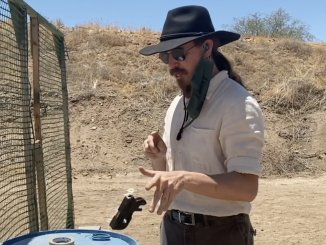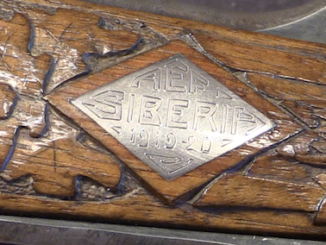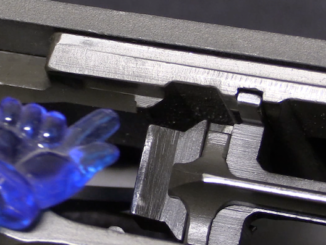This is lot #1478 in the upcoming RIA Premier Auction. It was scheduled for April, but has been postponed – check their web site for upcoming Online Only auctions every month, though!
When the US military held its automatic pistol trials in 1907 (actually beginning in December 1906…), Colt submitted a Model 1905 pistol. Despite what would be considered today to be significant problems, it was judged one of the best guns tested. A few changes were requested (more vertical ejection, a loaded chamber indicator, and a grip safety), and Colt was contracted to make 200 guns for a year-long field trial. Those guns would be the Model 1907, and they were issued to Cavalry units in Iowa, Minnesota, and the Philippines for an extensive trial.
The trial results were actually pretty poor. Unit commanders complained of significant jamming problems, broken parts (mostly firing pins and sears), difficulty getting accurate fire, and awkward handling on horseback. These issues were partially alleviated by a few modifications made to the guns in the latter half of 1909 (larger ejection ports and larger grip safeties, primarily). Ultimately, however, John Browning’s continued developmental work during the course of the field trial would result in a substantially improved mechanical design for the gun…




Great video for us early automatic pistol nerds. I would like to recommend a very relevant book: The Government Models by William H.D. Goddard.
Thanks.
Jim
Well, this seems to be Ian’s morning for comments from nerds named Jim… Just watched the video and the reference to the 10th Cav blew my Black (Military) History Nerd mind. There were four units of freed slaves that were recruited and formed into combat units at Ft. Scott Kansas in the aftermath of the Civil War. From what little I can tell – documentation is scant – the basis or “training cadre” of these guys who had decided to get the hell out of Arkansas, Oklahoma and Texas while the getting was good (in case slavery made a comeback) was the 1st Kansas Colored Militia.
Political Correctness Waiver – discussing US black military history involves using the words “colored” or “Negro” because they were part of the unit names and are inevitable in contemporary accounts of their exploits.
Anyway, the 1st Kansas was one hell of a bunch of soldiers, for guys who had been barefoot indentured field hands in recent memory, and were given blue uniforms and obsolete Prussian muskets (and white officers) and taught close-order drill and volley fire. I can’t figure out how to copy-and-paste on this tablet but if you google “Incident at Island Mound” it’s a pretty interesting account of the first encounter between Confederate and black Union soldiers. The homies kicked redneck butt, BTW. The battlefield (now Island Mound State Park) is a few hundred yards upstream on Miami Creek from a 160-acre parcel my grandfather and (later) uncle owned; the bronze statue of the black Union soldier on the courthouse lawn in my hometown of Butler, MO is worth a selfie if for some godforsaken reason you wind up in Butler.
Anyway, by 1867 or so there were enough recruitable freedmen in the Ft. Scott (which really was a fort then, with a town growing around it) area to form the 24th and 25th (Colored) Infantry and the 9th and (taa-daa!) 10 (Colored) Cavalry. These units were in pretty much constant combat from the time they were formed – the Kiowa in Kansas, the Apache in the Southwest, they pulled Teddy Roosevelt’s pinned-down butt off of San Juan Hill, the Moros for a decade or so, the 1917 Camp Logan Uprising in Houston (OK, so it was the largest mutiny in US Army history, but the 24th had a point when they went to war with the brutally racist Houston Police Department of the era)…. Amazing units, amazing history.
Just wanted to point out that one of the three units that tested the M1907 was a very combat-experienced African-American front-line unit. If anyone can come up with a 1907 that can be provenanced to the 10th Cav, the National Buffalo Soldier Museum here in Houston (an amazing resource) might be interested.
Thanks,very interesting comment.
One advantage of being as old as I am: My father served a hitch in the 13th. US Cavalry at Ft. D. A. Russell (it’s now part of Warren AFB) from 1920 to 1923. His outfit once went on maneuvers with the 10th. Cavalry. (Probably in and around what’s now Happy Jack Recreation Area, where I’ve occasionally picked up .30-40 and ’06 brass and bits of 75mm shells.) My father said the 10th. was very comme-il-faut militarily, at least during duty hours: everybody addressed everybody else by rank and last name.
Yes, the 10th. and 13th. were HORSED cavalry in those days. Pistols, Patton sabres, old oaken bucket, and all. I said I was old.
Ed –
Had to do a quick check on the phrase where you croaked Frog (to quote Bernard Cornwell in one of his Sharpe novels) but yeah, the Buffalo Soldiers seem to have been early adapters of the line you still hear… you have to be twice as good to be considered equal. By all accounts I’ve seen (that weren’t written by blind racists) the four Buffalo Soldier regiments were flawless on the parade ground and fearless in battle. It certainly didn’t hurt that they tended to be very self-contained communities (either on the fringes of the frontier or segregated from the white settlements they were protecting) where the sons of NCOs (moms being either local Native Americans or found during tours in Ft. Scott) were the recruit pool. A young lad who grew up in married-NCO barracks and had started off at the age of five or so currying horses and shining boots was a perfect little Spartan by the age of enlistment, after growing up in boot camp.
The whole history of Ft. Scott Kansas as a hub for refugee freedman families fleeing former Confederate/ slave states is pretty interesting. Basically, there were a lot of black homesteaders who started farms within patrol distance of the fort because they knew the Buffalo Soldiers would protect them from the Kiowa. Seems to me the Cheyenne may have been part of the narrative. Anyway by the 1880s or so there were quite a few crossroads church-and-a-store all-black communities around Ft. Scott. Which means that if an aunt doing geneology discovers that great-grandma was born in Nesbitt’s Corner (or whatever – I just made that up) in the early 1900s it means you are part black. Which came as a huge giggle to a friend from Kansas.
Really stupid question: Did anyone complain about the muzzle end of the slide getting mud stuck in it?
Some People complain about the .45 being overkill, but did any bovine army ever attack the US successfully? Exactly.
‘S funny you say that, but…
I can’t prove this via citation or, really, any corroboration at all, but I was once informed by a guy who’d been a cavalryman during the interwar years that the .45 was selected for the cavalry because the US, unlike the Europeans, took the view that the horse was the bigger target during a cavalry fight, and you thus shot at the horses instead of the men. Europeans were a bit too “in love” with their horses, and would not do that, so all their pistols (and, the other cavalry weapons…) were geared towards shooting men. Only the US was so unchivalrous that we would shoot someone’s favorite horsey…
The cows were stand-ins for the horses, and were part of the tests because they needed a proxy for the horses without mentioning that we were gonna be shooting at them first, intending to dismount the enemy cavalry before bothering to kill the horsemen.
Like I said–Entirely without provenance, but there ya go: He was taught this in training at a Cavalry post somewhere in the Western US during the mid- to late-1920s, early ’30s.
Using cows as stand-ins for horses actually makes quite a bit of sense, this was prior to WWI so cavalry charging openly was still a thing. That angle was truly lost on me.
As far as europeans not shooting at horses, I would put that firmly into the range of apocrypha, stuff that circulates in any army about any other army (we=clever they=dumb).
What I would consider more likely is that a different understanding of the role of cavalry informed the respective choices in weapons procurement. Most european armies simply saw cavalry, beyond recon and raiding, as a weapon against infantry and never considerd mounted troops facing mounted troops in a pistol firefight all that important, In the unlikely case you really come this close, either ride away, or, on the more heroic side, just ride over and poke ’em, that’s what you carried a saber for anyway.
And I highly doubt any soldier on foot of any creed or colour had any qualms about shooting some foreigners foreign horse, the loss rates from say, Sadowa, bear that out, but soldiers on foot were not getting any pistols anyway, pistols in europe were an officers weapon, often privately purchased, to prevent soldiers from defecting and themselves from getting captured, and any ol’ pipsqueak will do that just fine.
Delighted in perusing the article above, truly clarifies everything in detail, the article is fascinating and viable. Much thanks to you and waiting for your upcoming articles.
This is lot #1478 in the upcoming RIA Premier Auction. It was scheduled for April, but has been postponed – check their web site for upcoming Online Only auctions every month, though!